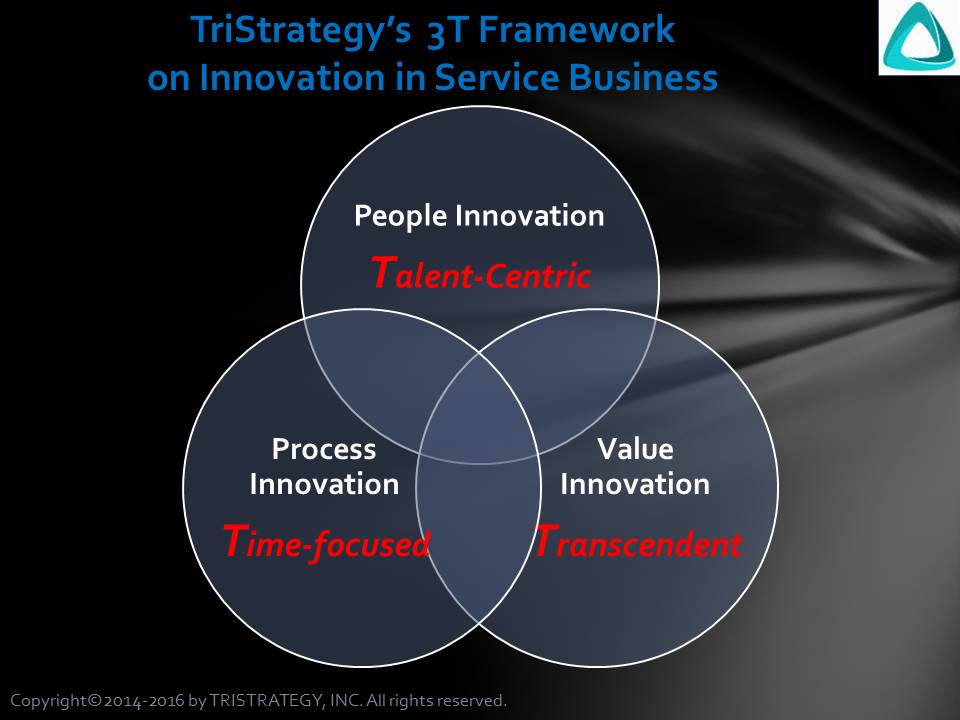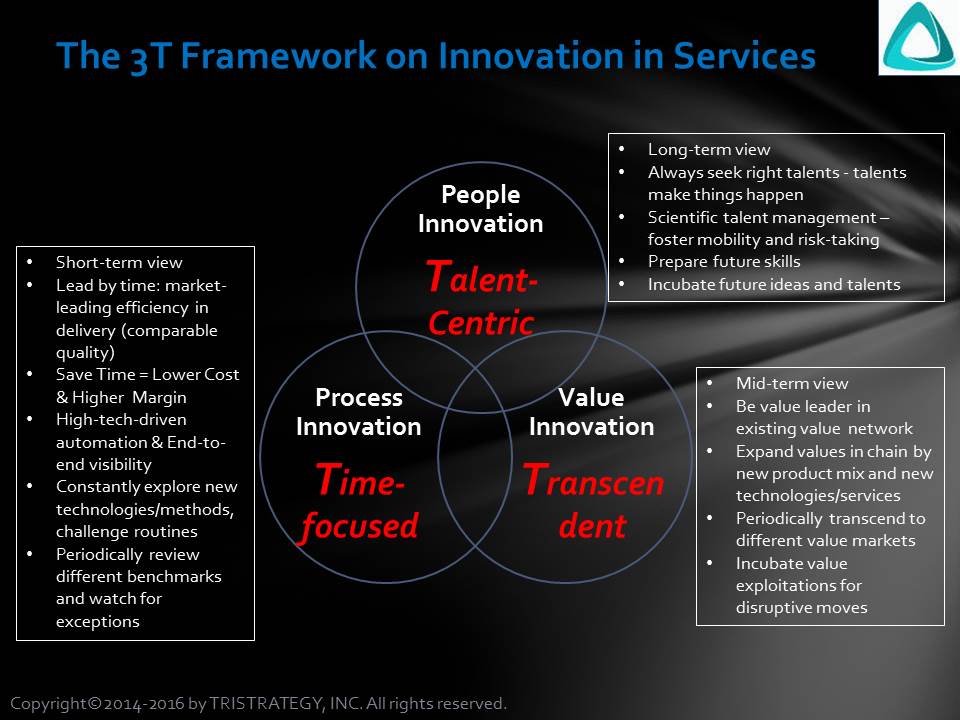Almost all businesses today are facing the forces of disruptive technologies. These forces can prove deadly for some long-time traditional businesses. Based on our observations and experiences, TriStrategist designed the “3T Innovation Framework” for a service business to innovate in the right way to stay current, stay ahead and prevent the threat of disruptive forces. The “3T” represents the three underlying concurrent themes for a service business to target on innovations: Talent-centric People Innovation, Time-focused Process Innovation and Transcendent Value Innovation.


TriStrategist thinks that compared with a product-focused company, it is harder for a service business to innovate or keep an innovative edge among competitions. Thus, a long-time service business can be even more vulnerable facing disruptive forces. There are several reasons to it:
1. A service business, even with sound management and constant innovative moves, tend to be on sustaining innovation mode** at best. It tends to stay on course for the continuity of the services and for the satisfaction of their customers. They are easily restrained from making quick or drastic changes by their customers. This renders them a lack of flexibility and versatility to deal with new, distinctively different disruptive forces on the market;
2. An established service business tends to have heavy upfront investments or fairly fixed profitability model. Dealing with a new emerging disruptive service model on the market could mean to uproot or change completely the existing model, which is often to too costly, by their traditional way of opportunity cost calculation, to make up a good financial case in decision making when there is still time to react;
3. In an existing service organization, the continuity of the service to serve their most valuable customers often imply some specialized skills and fixed procedures in the process. Routine work and mindset thus formed. People in these organizations are typically not equipped with the capabilities of quick mindset or skillset switching that are urgently needed to deal with the emerging disruptive forces. Even if the organization is keenly aware of the new forces and their threats, people in the organization, including decision makers tend to be reluctant to face them until it’s too late;
4. The disruptive force for a service tends to first attack in one or a few segments of the value chain, either by advanced technologies or innovative delivery mechanisms. Still it’s often hard for an existing service business to incorporate the new ideas quickly into their existing service model, either due to value market differentiation, technology incompatibility with the rest of the chain, or a lack of expertise in the new way. Thus, the existing business can easily lose the valuable time to combat the new wave, and more often than not, cost them the leading edge or potentially the entire business.
One good example is the movie rental business of Blockbuster vs. Netflix. Blockbuster, founded in 1985, had the heavy upfront brick-and-mortar investments in its numerous neighborhood stores and had dominant position in movie rental business for years. By targeting the same customers and essentially the same service business, Netflix, started in 2002, offered a new delivery mechanism with a lower monthly fee and the convenience of in-house delivery(also a time-saving value for some customers). Blockbuster saw Netflix’ new delivery model coming, but it was hard for them to abandon the existing store model and reset resources to immediately catch up. In fact Blockbuster’s store model had a higher profit margin (apart from the upfront investments) than the initial Netflix’ mail-in model. When they eventually tried to counter offer the mail-in service to their customers, it was already too late as Netflix’ new model has been adopted by the mainstream. Moreover, Netflix quickly started investing in streaming videos/movies which had a hugely enhanced time value in delivery, appealing more to the society thanks to the prevailing cable networks at that time. We all knew how the story ended: by 2010, Blockbuster filed its bankruptcy protection and never came out of it.
Another contemporary example can be seen in book publishing services. The traditional publishing houses have been using the same process for decades. They charged a percentage for editing, publishing and promoting the books for the authors and the entire process is slow. When self-publishing service first came into reality, traditional publishing houses couldn’t deal with it immediately: both due to the different value market (selective authors vs. every writer) and the incompatibility of the publishing process and fee structure. Still self-publishing service poses a serious disruptive force against the traditional publishing service. Today it has started moving up the value chain to attract even the established authors for both the time and fee savings. The battle is still intensely on.
In today’s technology service sector, the battles are even more fierce and scary. TriStrategist will continue to study some of these cases in the subsequent blogs.
“All things are ready, if our mind be so.” – William Shakespeare, in Henry V.
Therefore an effective innovation framework in place is essential for any service business to stay innovative throughout the organization, to smartly decide on resource and investment allocations, and to keep market leadership by preemptively dealing with any potential disruptive force in the current age of explosive innovations, if not becoming a creator. TriStrategy’s 3T Innovation Framework is designed to help on these purposes.
* Note: This blog is a continuation on the subject of Innovation and Services Business, first posted on May 17, 2014. TriStrategist will continue to refine the 3T Innovation Framework from our management consulting work and observations.
** Note: For the definitions of sustaining vs. disruptive innovations and the value network theory on disruptive innovations, please check out Harvard Business School Clayton M. Christensen’ publications and other related discussions.
